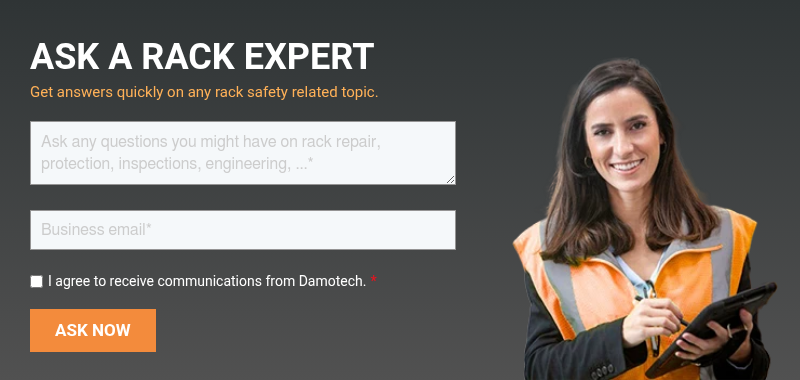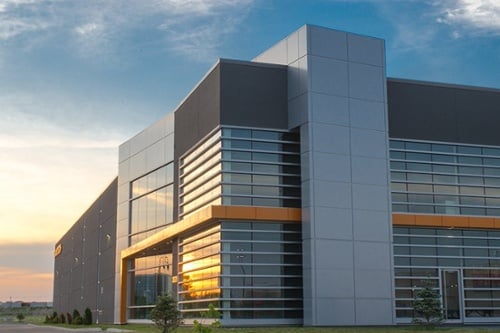A warehouse is more than racks and pallets—it’s a dynamic, interconnected system where every warehouse machine plays a role in flow, safety, and throughput. Every piece of material handling equipment, from powerful conveyor belt systems to versatile robotic warehouse systems, works together to keep goods flowing, ensure employee safety, and maintain efficient operations.
At Damotech, we understand that while machinery transports your goods, it’s your racking system that provides safe support for them all.
What Is Material Handling Equipment (MHE)?
Material handling equipment (MHE) includes tools and warehouse machinery for moving materials, lifting, processing, securing, loading, and unloading. These range from electric material handling equipment, such as AGVs and AMRs, to heavy-duty material handling equipment, including mobile cranes, scissor lifts, and vacuum lifters.
The most efficient warehouses blend equipment, training, and rack compliance (capacity labels, inspections, and standards).
1. Transporting & Moving Materials
Conveyor Systems
Conveyors automate the transport of materials along fixed paths. Whether it’s a versatile conveyor belt system, a heavy-duty roller conveyor, or an overhead conveyor freeing up valuable floor space, these systems drastically reduce manual labor and increase throughput.
Common types:
- Belt conveyors for lightweight items and long distances.
- Roller conveyors for heavier cartons and totes.
- Overhead conveyors to maximize floor space.
Most common? The conveyor belt system due to versatility.

Automated Guided Vehicles (AGVs)
Driverless, electric material handling equipment that follows set paths, steadily transporting materials between receiving, buffer, and packing areas.

Autonomous Mobile Robots (AMRs)
AMRs use sensors and smart navigation to move materials anywhere on the warehouse floor. They adapt to dynamic aisles, docking with racks, workstations, or industrial turntables. They play a crucial role in robotics and autonomous systems at industry leaders such as Walmart.

Tuggers and Tow Tractors
These machines pull multiple carts at once (“milk runs”), reducing the need for single-pallet trips and forklift congestion in high-volume operations.

Cart Systems
From order-picking carts to warehouse loading dock equipment staging carts, manual and powered carts complement AGVs/AMRs for short runs.

2. Lifting & Positioning Equipment
Warehouse Cranes and Mobile Cranes
From massive overhead cranes to nimble mobile cranes, these machines lift and position heavy loads with precision and accuracy. Skilled mobile crane operators are crucial for ensuring safe and flexible lifting both inside and outside the warehouse.

Hoists and Winches
- Manual hoists for lighter, occasional lifts.
- Electric hoists for frequent, heavier-duty cycles.
Both are essential load-handling equipment for vertical moves and precise placement.

Lift Tables and Scissor Lifts
Scissor lifts (including automotive models) raise goods or workers to ergonomic heights for put-away, maintenance, or access to hard-to-reach inventory.

Vacuum Lifters
Vacuum lifters utilize suction and air pressure to securely grip and move sheets, panes, drums, and delicate items, such as glass or sheet metal, thereby reducing the risk of injury and enhancing handling efficiency.

3. Handling & Processing Loads
Robotic Systems
Warehouse robotic systems, built on advanced robot operating systems, automate repetitive tasks like picking, palletizing, and case handling. Integrated with WMS and industrial turntables, they dramatically boost speed and accuracy.

Industrial Turntables
Heavy-duty motorized turntables rotate pallets or workpieces for assembly or quality control, thereby reducing strain and minimizing the need for manual repositioning.

4. Securing, Loading & Unloading
Dock Equipment
Critical for warehouse safety, loading dock safety equipment (levelers, vehicle restraints, seals, bumpers) ensures safe transitions during loading and unloading. Proper warehouse loading dock equipment protects against slips, falls, and trailer gaps, and aligns with OSHA requirements.

Pallet Wrappers and Stretch Wrappers
Automatic wrappers stabilize pallet loads for storage and transport, reducing film waste and protecting product integrity.

Warehouse Safety Essentials
Safety is non-negotiable. Here’s how to safeguard your people, throughput, and assets:
- Know and post rack load capacity. Display capacity labels/plaques and keep LARCs up to date, especially after beam changes. Overloading and damage change the capacity and risk.
- Follow recognized standards. The RMI/ANSI MH16.1 standard covers design, testing, and utilization of industrial steel storage racks, including stability, seismic, anchors, baseplates, and posting load data. Use it with local codes and a qualified rack engineer.
- Train, inspect, and maintain. Build a cadence (daily/weekly observations, monthly in-house checks, annual third-party inspections), supported by checklists and software. Damotech’s Rack Safety Flywheel is a proven framework to operationalize knowledge: inspection → insight → maintenance → protection + training.
- Protect high-impact zones. End-of-aisle intersections and AMR/forklift conflict points require guarding and engineered repairs when necessary.
- PPE and safe work practices. Reinforce warehouse safety gear, manual handling, machine guarding, and hazard reporting to cut injuries and downtime.

How Damotech Can Help
Machinery moves your goods, but your racking safely supports the entire operation.
If you’ve changed beam levels, added AMRs, or noticed upright/anchor damage, it’s time to review load capacity, perform a compliance inspection, and harden high-risk zones with protection or engineered repair kits.
Ready to optimize your warehouse? Consult with a Damotech rack engineer for a rapid baseline and a comprehensive plan that can be implemented network-wide.
- Request a Rack Inspection (annual compliance + software tracking)
- Calculate/Update Load Capacity & Labels (LARCs, plaques)
- Guard & Repair (DAMO GUARD, DAMO PRO, installation best practices)
- Build a rack safety program or optimize your existing program
Quick Answers (FAQ) About Material Handling Equipment
What equipment is used for material handling?
Everything that moves, lifts, processes, or secures goods: conveyor systems, AGVs/AMRs, tuggers and tow tractors, carts, cranes, hoists, scissor lifts, vacuum lifters, industrial turntables, dock equipment, and pallet/stretch wrappers.
How do vacuum lifters work?
They create suction at the contact surface to grip an item. A pump or venturi system maintains negative pressure while the load is lifted or tilted, making it ideal for handling sheet metal, glass, or other smooth, non-porous materials.
What is a warehouse crane called?
Typically, it’s an overhead crane (bridge or gantry) inside the facility, or a mobile crane (rubber-tired or truck-mounted) for flexible or outdoor lifts.
What is a warehouse crane?
A lifting system that moves heavy loads vertically and horizontally across a defined span (overhead) or anywhere on-site (mobile) using hooks, slings, or specialized attachments.
What are the two main types of hoists?
Manual and electric (with pneumatic also used in some plants). Electric hoists support higher duty cycles and heavier loads.
What is a conveyor in a warehouse?
A conveyor is a fixed-path system—such as a belt or roller conveyor—that automatically moves items along a predetermined route, reducing manual handling and dwell time.
What is a Robotic Operating System (ROS)?
A software framework allowing robotic systems (like AMRs or robotic arms) to perceive, plan, and execute tasks—coordinating sensors, navigation, and motion control in the warehouse.
What is the difference between a conveyor and a sorter?
A conveyor transports items from point A to point B, while a sorter diverts items to specific destinations for order routing, as part of an automated conveyor system.
What are the three types of conveyors?
Belt, roller, and overhead conveyors.
What is the most common type of conveyor?
The conveyor belt system is versatile across different sizes, weights, and distances.
What equipment is used for loading and unloading?
Dock levelers, vehicle restraints, dock lifts, bumpers, seals/shelters, dock lights, emergency stops, clear aisle markings, and communication systems.
Which safety precautions apply to material handling equipment?
Train operators, post and respect rack load capacities, maintain clear aisles and flue spaces, inspect anchors and uprights, use PPE, and always follow recognized standards (like RMI/ANSI MH16.1) and local codes.











